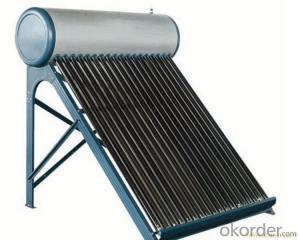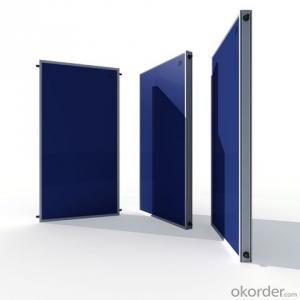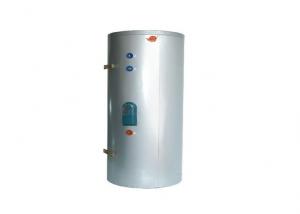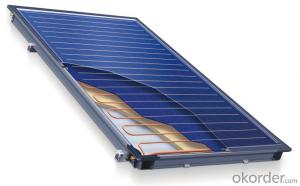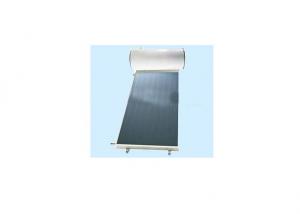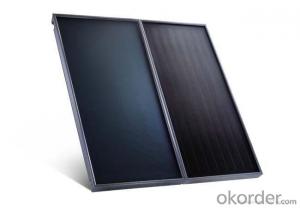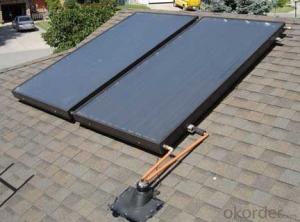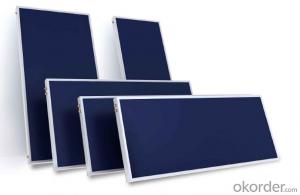Pressurized Heat Pipe Solar Water Heater System 2015 New Design
- Loading Port:
- China main port
- Payment Terms:
- TT OR LC
- Min Order Qty:
- 1 set
- Supply Capability:
- 6000 set/month
OKorder Service Pledge
OKorder Financial Service
You Might Also Like
Introduction of Non-Pressure Solar Water Heater:
Non-pressure Solar Heater is one of the most economical solar water heating device with pretty high efficiency at the same time. It consists of hot water storage tank, solar vacuum tubes with mouth plug in storage tank, and bracket supporting tank and tubes.When cold water in evacuated tubes is heated with solar irradiation, as the specific gravities of hot water and cold water are different, hotter water goes upward to storage tank and colder water goes downward to glass tubes. through this continuous circulation, the cold water in storage tank will be gradually heated till sunset.
Specialty:
1. High thermal performance and working temperature: the heat exchanging rate even in winter can up above 55%.
2. Heat collecting efficiency is at least 20% above common solar systems.
3. Work in all day and all season: no matter any corner of the world, this system can work well even -40℃ to avoid the tube freezing problem.
4. Reliability: No water following through the tube, so water scale can not generate and tube cracks could be avoided, the system still can keep working even with some damaged tubes.
5. It can connect with water tap and work automatically with pressure0.6Mpa, bring enjoyable washing experience.
6. Safety: P/T valve would release pressure and temperature to protect tank..
Technical Specification:
1. Outer tank material: SUS304 stainless steel or powder coated color steel
2. Inner tank material: 1.2mm thick SUS304 food grade stainless steel ( Optional material SUS316L)
3. Vacuum tube material: borosilicate glass 3.3; AL-SS-CU absorb coating, with copper heat pipe inside
4. Frame material: 1.2mm thickness stainless steel
5. Insulation material: 55mm thickness polyurethane
6. Suitable for mains pressure water(up to 8 bar/116psi)
7. Easy plug-in installation
8. Install the T/P valve on the pressurized tank
9. Seal material: Stabilized High Temperature Silicon
Outer tank material: SUS304 stainless steel or powder coated color steel
Inner tank material: 1.2mm thick SUS304 food grade stainless steel ( Optional material SUS316L)
Vacuum tube material: borosilicate glass 3.3; AL-SS-CU absorb coating, with copper heat pipe inside
Frame material: 1.2mm thickness stainless steel
Insulation material: 55mm thickness polyurethane
Suitable for mains pressure water(up to 8 bar/116psi)
Easy plug-in installation
Install the T/P valve on the pressurized tank
Seal material: Stabilized High Temperature Silicon
19. Vacuum Tube | 20. Size (mm) | 21. Φ47*1500 / Φ58*1800 / Φ70*2100 | |||||
22. Tube (pcs) | 23. 10 / 12 / 15 / 18 / 20 / 22 / 24 / 30 / 36 / 42 | ||||||
24. Material | 25. Borosilicate 3.3 glass, magnetron spluttering selective coating | ||||||
26. Coating | 27. Single-target AL-N/AL or Three-target AL/N-Cu-SS | ||||||
28. Water Tank | 29. Capacity | 30. 80L ~ 500L for hot water storage tank | |||||
31. Inner tank | 32. Food-grade stainless steel SUS304-2B / SUS316 | ||||||
33. Insulation | 34. High-density polyurethane foam with 70~80 hour heat preservation | ||||||
35. Tank shell | 36. Food-grade stainless steel SUS304-2B | ||||||
37. Bracket | 38. Shaped strong aluminum alloy structure adaptable for flat or slope roof | ||||||
39. Accessories | 40. Anti-aging silicon seals, Dustproof seals, Air-vent cap, Stainless screws | ||||||
41. Auxiliary Devices | 42. Assistant tank, Intelligent controller, Electrical heater, Magnesium anodes | ||||||
43. Tilt Angle | 44. 25 ~ 50° | ||||||
45. Water Output | 46. 45 - 95°C | ||||||
47. Hail Resistance | 48. Φ25mm diameter | ||||||
49. Model Number | 50. Solar Vacuum Tube | 51. Tank 52. Liter | 53. System 54. Liter | 55. Container Loading Qty /sets | |||
56. Size /mm | 57. Qty /pcs | 58. 20GP | 59. 40GP | 60. 40HQ | |||
61. VNS-58SA12-100 | 62. Φ58*1800 | 63. 12 | 64. 100 | 65. 132 | 66. 58 | 67. 119 | 68. 140 |
69. VNS-58SA15-130 | 70. 15 | 71. 130 | 72. 170 | 73. 54 | 74. 108 | 75. 131 | |
76. VNS-58SA18-150 | 77. 18 | 78. 150 | 79. 198 | 80. 43 | 81. 86 | 82. 105 | |
83. VNS-58SA20-170 | 84. 20 | 85. 170 | 86. 223 | 87. 40 | 88. 80 | 89. 97 | |
VNS-58SA24-200 | 24 | 200 | 263 | 35 | 70 | 85 | |
VNS-58SA30-250 | 30 | 250 | 329 | 28 | 56 | 68 | |
VNS-58SA36-300 | 36 | 300 | 395 | 23 | 47 | 57 | |
Product Show
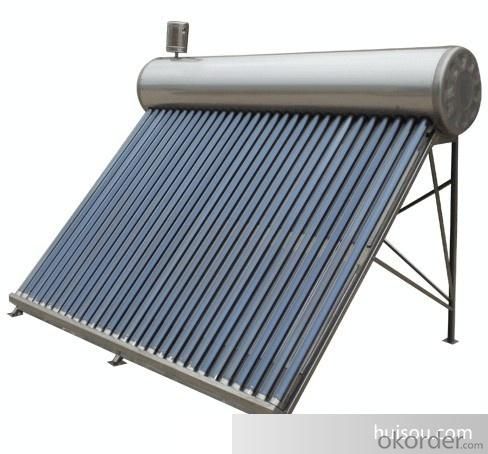
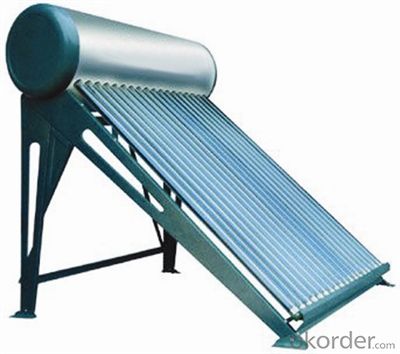
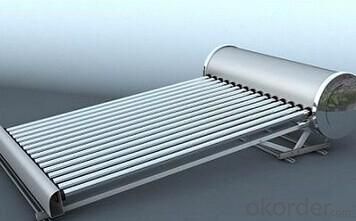
Our Services
1. OEM service
2. Warranty: 5 years
3. Considerable after sale service
Color steel Compact pressure Thermal solar heater
FAQ:
1. What’s the delivery time?
10 days after receiving deposit.
2. How long is the warranty?
5 years for whole system, 1 year for accessory
3. What’s your production capacity?
6000sets/month
4. What’s the MOQ?
1 set.
5. What’s your payment term?
Container: 30% T/T in advance for deposit, 70% T/T before shipment for fist order.
70% T/T after seeing copy of B/L from second order
Sample: 100% T/T in advance
Other choices: L/C at sight.
6. What certifications do you have?
CE, SOLAR KEYMARK, SRCC and etc.
- Q:Can solar collectors be integrated into existing buildings?
- Yes, solar collectors can be integrated into existing buildings through various methods such as rooftop installations, solar facades, or even solar windows. Retrofitting existing buildings with solar collectors allows for the harnessing of solar energy without the need for major structural changes or rebuilding.
- Q:What is the impact of wind on the performance of solar collectors?
- The impact of wind on the performance of solar collectors can be both positive and negative. On one hand, wind can help to cool down the solar collectors and prevent them from overheating, which can improve their overall efficiency. On the other hand, strong winds can create turbulence and increase heat losses from the collectors, reducing their effectiveness. Therefore, it is important to consider the local wind conditions and design the solar collector system accordingly to optimize its performance.
- Q:Can solar collectors be used for heating emergency response facilities?
- Yes, solar collectors can be used for heating emergency response facilities. Solar collectors, such as solar thermal systems, can efficiently capture and convert sunlight into heat energy, which can be used for heating water or air in buildings. This renewable energy source can be particularly useful for emergency response facilities as they often require heating during critical situations, especially in areas where grid power may be unreliable or unavailable. Additionally, solar collectors do not produce greenhouse gas emissions, making them a sustainable and environmentally friendly choice for heating emergency response facilities.
- Q:Can solar collectors be used in art installations?
- Yes, solar collectors can definitely be used in art installations. They can be incorporated into various creative designs to harness solar energy and power different elements of the installation. This not only adds an eco-friendly aspect to the artwork but also showcases the potential of renewable energy in a visually captivating way.
- Q:Can solar collectors be used in conjunction with geothermal systems?
- Yes, solar collectors can be used in conjunction with geothermal systems. The solar collectors can provide additional heat to supplement the geothermal system's heating capacity, increasing energy efficiency and reducing reliance on fossil fuels. This combination can enhance the overall performance and sustainability of the heating system.
- Q:Can solar collectors be used in trains?
- Yes, solar collectors can be used in trains. Solar panels can be installed on the rooftops of trains to harness solar energy and power various onboard systems such as lighting, air conditioning, and electronic devices. This helps reduce fuel consumption and greenhouse gas emissions, making trains more sustainable and energy-efficient.
- Q:Can solar collectors be used for heating industrial facilities in winter?
- Heating industrial facilities in winter is possible by utilizing solar collectors. These devices, also known as solar thermal systems, are designed to capture the sun's energy and convert it into heat. This heat can be utilized for various purposes, including heating industrial facilities. To incorporate solar collectors into the existing heating system and warm industrial facilities in winter, they can be integrated. They have the capability to preheat the water or air that circulates throughout the facility, thus reducing the reliance on conventional heating sources like fossil fuels or electricity. Considering the substantial heat requirement of industrial facilities, solar collectors can be scaled up to meet these demands. Multiple collectors can be installed and connected either in series or parallel to increase the overall heating capacity. Additionally, thermal storage systems can be employed to store excess heat produced during sunny periods, which can then be used during cloudy or nighttime conditions. The use of solar collectors brings significant advantages to industrial facilities in terms of cost savings and environmental sustainability. By harnessing solar energy, these facilities can decrease their dependence on fossil fuels, leading to reduced energy bills and a smaller carbon footprint. Moreover, the implementation of solar collectors enables industrial facilities to comply with environmental regulations and contribute to their corporate social responsibility objectives. However, it is crucial to carefully assess the specific requirements and limitations of each industrial facility before introducing solar collectors for heating purposes. Factors such as available space, facility orientation, and heating demands should be meticulously evaluated to ensure the effectiveness and efficiency of the solar thermal system. In conclusion, solar collectors can certainly be utilized to heat industrial facilities in winter. They offer a renewable and sustainable alternative to conventional heating sources, providing cost savings and environmental benefits to industrial facilities.
- Q:Can solar collectors be used for heating train stations?
- Yes, solar collectors can be used for heating train stations. Solar thermal collectors can capture the energy from the sun and convert it into heat, which can then be utilized for heating purposes in train stations. This renewable energy source can effectively provide heating while reducing reliance on traditional fossil fuel-based heating systems, making it a sustainable option for train station heating.
- Q:Can solar collectors be installed on flat roofs?
- Yes, solar collectors can be installed on flat roofs. In fact, flat roofs are often ideal for solar panel installations due to their unobstructed space and easy accessibility for maintenance and installation purposes.
- Q:Can solar collectors be used for heating schools and universities?
- Yes, solar collectors can be used effectively for heating schools and universities. Solar thermal systems can generate heat by harnessing the energy from the sun and transfer it to the heating systems of educational institutions. This renewable energy source can significantly reduce heating costs and carbon emissions, making it a sustainable and economically viable option for educational facilities.
1. Manufacturer Overview |
|
|---|---|
| Location | |
| Year Established | |
| Annual Output Value | |
| Main Markets | |
| Company Certifications | |
2. Manufacturer Certificates |
|
|---|---|
| a) Certification Name | |
| Range | |
| Reference | |
| Validity Period | |
3. Manufacturer Capability |
|
|---|---|
| a)Trade Capacity | |
| Nearest Port | |
| Export Percentage | |
| No.of Employees in Trade Department | |
| Language Spoken: | |
| b)Factory Information | |
| Factory Size: | |
| No. of Production Lines | |
| Contract Manufacturing | |
| Product Price Range | |
Send your message to us
Pressurized Heat Pipe Solar Water Heater System 2015 New Design
- Loading Port:
- China main port
- Payment Terms:
- TT OR LC
- Min Order Qty:
- 1 set
- Supply Capability:
- 6000 set/month
OKorder Service Pledge
OKorder Financial Service
Similar products
New products
Hot products
Hot Searches
Related keywords
